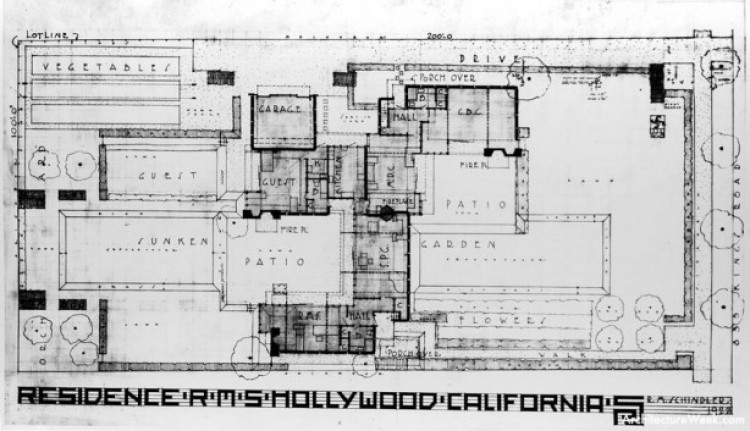Photographed in LA in 1931, barefoot Galka Scheyer adopts a modern attitude in the sundrenched window of Rudolf Schindler’s revolutionary Kings Road House which proposed new arrangements for living and working, defining what it means to be modern, at least in California.
![King's Road House001[4]](https://149616175.v2.pressablecdn.com/wp-content/uploads/2012/01/Kings-Road-House0014-e1327708358581.jpg) Designed in 1921 for two couples, four identical studio spaces placed in a pinwheel pattern frame two courtyards. Studio spaces flow directly out into private exterior courts through window walls and sliding doors. The interior and exterior are integrated to such an extent that the courtyards’ hedged boundaries effectively form the fourth wall of the studio interiors. The interior spaces are just as casual and ambiguous in proscribed use and privacy. Each studio provides individual work/play space promoting radical possibilities for social relations from independent to communal. The history of the house reflects the possibilities from communal habitat and salon for Schindler and Neutra family to separate quarters for the ultimately separated Rudolf and Pauline Schindler.
Designed in 1921 for two couples, four identical studio spaces placed in a pinwheel pattern frame two courtyards. Studio spaces flow directly out into private exterior courts through window walls and sliding doors. The interior and exterior are integrated to such an extent that the courtyards’ hedged boundaries effectively form the fourth wall of the studio interiors. The interior spaces are just as casual and ambiguous in proscribed use and privacy. Each studio provides individual work/play space promoting radical possibilities for social relations from independent to communal. The history of the house reflects the possibilities from communal habitat and salon for Schindler and Neutra family to separate quarters for the ultimately separated Rudolf and Pauline Schindler.

“Our rooms will descend close to the ground, and the garden will become an integral part of the house. The distinction between the indoors and the out-of-doors will disappear. Our house will lose its front-and-back door aspect. It will cease being a group of dens, some larger ones for social effect, and a few smaller ones (bedrooms) in which to herd the family. Each individual will want a private room to gain a background for his life. He will sleep in the open. A work-and-play room, together with the garden, will satisfy the group needs. The walls will be few, thin, and removable. All rooms will become parts of an organic unit instead of being small separate boxes with peep-holes.” (Schindler, “Care of the Body,” Los Angeles Times, 1926).



I’m excited by the studios in a pinwheel around the courtyards and the walls that disappear to let the landscape roll into the interiors. Did you take the photo of the studio-fireplace-moveable wall?… wonderful. Those transoms are like a step towards heaven.
I’m certain I photographed the studio-fireplace-moveable wall many times in the last thirty years, before I became digitized. Regarding heaven, I didn’t discuss the outdoor sleeping baskets up on the roof. I would like to credit aidan for his inspirational photos at http://www.flickr.com/photos/transcribble/521474740/in/photostream/.